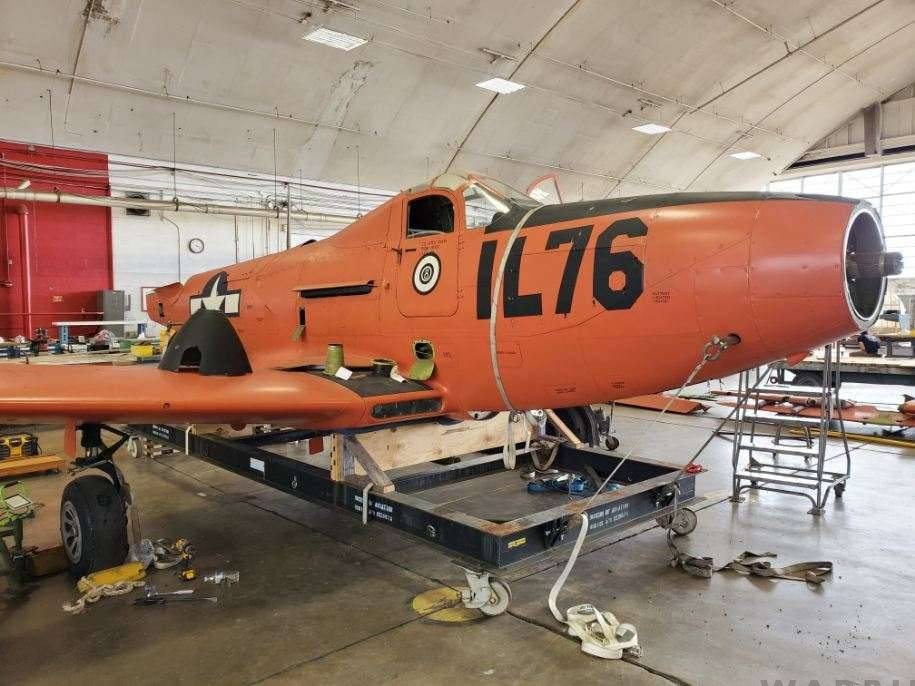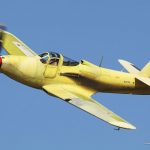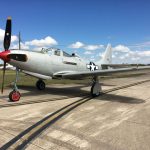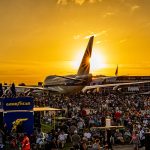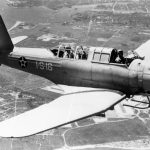The National Museum of the U.S. Air Force (NMUSAF) in Dayton, Ohio has sent their rare Bell P-63E Kingcobra to go on display at the Museum of Aviation in Warner Robins, Georgia. The Museum of Aviation serves as a satellite facility to the NMUSAF, the second largest within their system. The P-63, of course, emerged from the earlier Bell P-39 Airacobra, which it closely resembles. The U.S. Army Air Forces never used the P-63 in combat, although some were used for training purposes. It is perhaps for this reason that the aircraft is on the move from Dayton, as a number of other less prominent types in their collection have also been shifted off campus in recent months. The type did see some combat in WWII, however, with more than half of the roughly 3,300 P-63s built ending up as lend-lease exports; the Soviet Union received 2,456 Kingcobras while Free French forces obtained a further 300 examples.
The aircraft in question, Bell P-63E-1-BE Kingcobra 42-11728, never saw combat, but has an interesting history none-the-less. She rolled off Bell’s production line in Buffalo, New York during 1945. Unlike many of her brethren, this Kingcobra did not end up in the Soviet Union as part of the Allied Lend Lease effort. Instead, the aircraft went back to its manufacturer under bailment for a variety of flight test initiatives. This actually saw Bell place the aircraft on the U.S. civil registry as N41964 in February, 1946. In June that year, Bell modified the Kingcobra to include a second cockpit behind the engine, although they removed this addition by 1948. The P-63E was quite a rare model of Kingcobra, with only 13 of the variant produced, but the U.S. Government supplied five examples (42-11727 through -11731) to Honduras in October, 1948. Alongside the handful of P-38 Lightnings which Honduras also received, these aircraft became the first high-performance fighters in the Fuerza Aerea Hondurena (Honduran Air Force). Interestingly, all five of these aircraft still survive in some form or another and 42-11727 is also on the books with the NMUSAF, albeit presently on loan to the Pima Air & Space Museum in Tucson, Arizona.
Unfortunately, 42-11728 suffered a landing accident upon arriving in Tegucigalpa, Honduras on October 15th, 1948, relegating the airframe immediately into serving as a spares source for the other four Honduran examples. 42-11728 remained in that nation until Bell Aircraft re-acquired her in 1957. They performed a rapid, though comprehensive restoration, placing her on the U.S. civil registry that year, again as N41964. As part of this work, Bell returned the aircraft to a bare-metal, polished aluminum scheme, with her old U.S. Army Air Forces serial number on the tail. They presented the Kingcobra to the NMUSAF as a gift in January, 1958. She remained in Dayton on display as such through the 1980s, but sometime before the new millennium, the NMUSAF repainted the fighter to resemble one of the bright orange RP-63s Flying Pinball Machines. With armament removed and armor plate installed, these aircraft served as flying targets to help train bomber crews in the art of aerial gunnery. Rather than real .30 cal bullets, the trainee gun-aimers aboard aboard a bomber would fire frangible rounds at the RP-63s, with bullet strikes causing a light to illuminate in the fighter’s nose (where the 37mm cannon used to be) – hence the pinball moniker. In theory, these training rounds would break up upon hitting the fighter, rather than doing serious damage to the airframe, but it must have been a daunting experience for any pilot brave – or crazy enough – to fly the Kingcobra into such a situation! There’s a great article on the subject HERE.
Other than the unusual paint scheme, the NMUSAF never fully converted their P-63 into a formal Flying Pinball Machine, so it lacked the modified armor plate and lighting, it was nice to see a representative of this unusual variant on display. The NMUSAF has recently been redistributing some of their lesser exhibits of late, however, and had moved the Kingcobra into storage in recent years. It is good to know that she won’t be in hiding for much longer. The Museum of Aviation has expressed their intent to repaint the aircraft when they receive it, so it will be interesting to see what scheme they come up with once they make a decision.
The P-63’s fuselage left Dayton for Georgia last week, with the video below showing its departure.
Another aircraft on the move from Dayton, Ohio to Warner Robins, Georgia is Beech C-45H Expeditor 52-10893, also part of the NMUSAF collection. According to the Museum of Aviation website, this airframe will likely be making the journey east via C-17. The images below show the aircraft, partly disassembled, in the NMUSAF restoration hangar.









